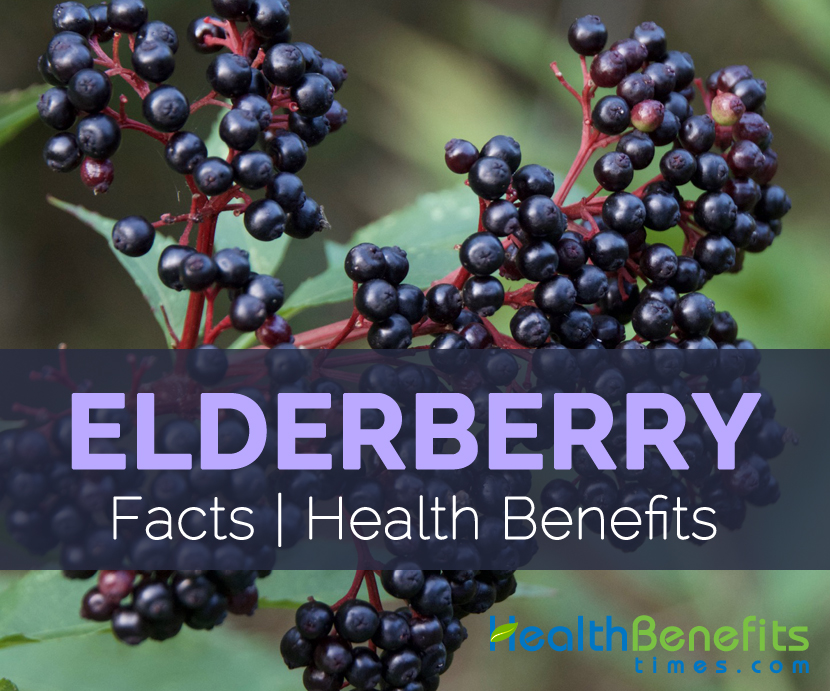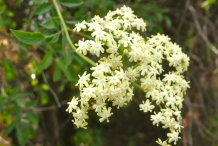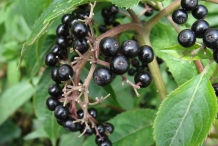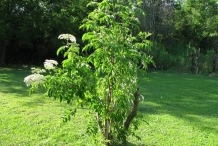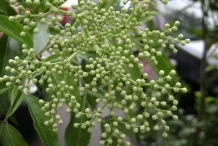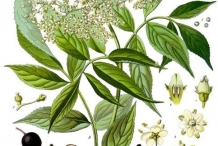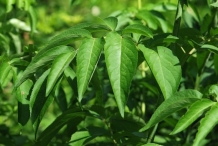| Elderberry Quick Facts |
| Name: |
Elderberry |
| Scientific Name: |
Sambucus nigra |
| Origin |
Native to Europe, but has been naturalized to the Americas. |
| Colors |
Green berries while young that turn red then dark purple to black berry as soon as they ripen. |
| Shapes |
Drupe, 8 to 10 mm, globose |
| Taste |
Tart taste |
| Calories |
106 Kcal Kcal./cup |
| Major nutrients |
Vitamin C (58%),
Iron (29%),
Dietary Fiber (26.84%),
Vitamin B6 (25.69%),
Copper (9.78%), |
| Health benefits |
Protection from Cold, Beneficial for Skin, Rich in Antioxidant, Healthy Immune Functions, Brain Function |
| More facts about Elderberry |
Elderberry scientifically known as Sambucus nigra is actually a delightful and advantageous fruit. Elderberry is also known by different name which include Black Elder, Bore Tree, Common Elder, Danewort, Pipe Tree, Bour Tree. Small, round elderberry is actually a storeroom of various health promoting nutrients, vitamins and minerals. Generally Elderberry can be found in different colors some well-known varieties of Elderberry includes Adams No. 2, York, Johns, Scotia, Beauty and many more. Elderberry is a tiny round fruit which is normally green while young which turn red then dark purple to black berry as they ripen. 8 to 10 mm purple or black berry can be harvested by July and the season lasts until September. Elderberries have distinctly tart and acidic flavor and somewhat tart taste. As soon as the fruit ripens hundreds of elderberry form a single cluster.
Plant:
Elderberry plant is deciduous branching shrub or small tree sized 10 m tall along with vertical shoots from the base and curving twigs. It is found growing is sunny locations and can tolerate rich, moist, slightly acidic dry to wet soils. Barks are light green when young and it gradually changes to coarse grey outer bark along with lengthwise wrinkling. Elderberry plant has pinnately compound leaves which are up to 12 inches long consists of central axis with usually 4 to 6 paired leaflets. Leaflets are usually ovate to elliptic 7 inches long along with prolonged tip and mostly wedge shaped base, margins are toothed. Generally flowers are Pentamerous, actinomorphic, bisexual white, 3/16 to 1/4 inch across, in broad, conspicuous clusters up to 10 inches or more in diameter with somewhat stinking odor are found blooming from May to July.
History:
The plant is native around arctic regions of Northern hemisphere and is now grown in commercial scale throughout the world. Elderberry is very common in most of Europe which includes Scandinavia and northwest, Asia Minor, Africa, Caucasus to Western Siberia. Its accepted distribution area reaches in Norway, Lithuania.
Nutritional Value
Elderberry is a good source of nutrients, vitamins, minerals. Consuming 145 gram of this fruit supplies, 52.2mg Vitamin C, 2.32mg Iron, 10.2g Total Dietary Fiber, 0.334mg Vitamin B6, 26.68g carbohydrates, 0.088mg copper, 406mg potassium, 0.102mg Vitamin B1, 57mg Phosphorus, 0.087mg Vitamin B2 and 44 µg Vitamin A. Moreover many Amino acids like 0.132g of Phenylalanine and Tyrosine , 0.019g of Tryptophan, 0.042g of Methionine and crystine, 0.087g of Leucine, 0.039g of Isoleucine, 0.048g of Valine, 0.039g of Threonine and 0.022g of Histidine are also found in 100 gram of the fruit.
Health benefits of Elderberry
Small, round elderberry is actually a stockroom of several health endorsing nutrients, vitamins and minerals. Consuming this berry regularly can help us to be healthy and active. Selected distinctive health benefits of Elderberry includes its ability to improves bone health, protection from cold, boost your skin health, stimulates immune system, reduces Gingival effects, improves brain health, boost eye health and improves heart health.
1. Protection from Cold
Research done by Griffith’s Menzies Health Institute Queensland (MHIQ) reveals that an elderberry supplements safeguard from different cold and flu symptoms due to long-haul flights. Travelling Intercontinental air could be very difficult and may disturb the passenger’s physical and mental comforts. As we all know that fatigue and Jet lag are one of the best known problems, upper respiratory symptoms is also experiences by many holidaymakers. For all these problems associated with respiratory bacteria and influenza viruses, Elderberry extract is proven to be most effective Cure.(1)
2. Beneficial for Skin
Humble Elderberry provides the natural boost to the skin, which expensive moisturizers and cosmetic surgery may not offer. In accordance with the research report, proper healthy diet will offer protection against heart disease as well as skin damage. Healthy food components have proven to enhance the Skin’s structure. It is a proven fact that the active components which are present in Elderberry have got and anti-inflammatory features that may be essential for us to remain fit and healthy.(2)
3. Rich in Antioxidant
Chokeberry, black currant and Elderberry are collectively known as “purple berries” because of its dark color. Research has discovered that purple berries have nearly 50% higher Antioxidants compared to other varieties of berry and have prospective to offer more health benefits such as Alzheimer’s, heart disease, cancer. In the near future due to its beneficial antioxidant qualities, Elderberry can be found using in a growing number of specialty health drinks, foods and nutraceuticals.(3)
4. Healthy Immune Functions
Research has discovered that elderberry is loaded with Vitamin C, which encourages the manufacture of White blood Cells and assists immune cells to function effectively. It safeguards White blood Cells (WBC) from oxidative damage and promotes to function properly. Additionally, elderberries include anthocyanins, molecules few scientists think may enhance the immune system. A single cup serving of Elderberry (145 g) has 58% of the daily required intake.
5. Brain Function
Oxygen is required for brain to function efficiently. Iron is essential to receive the oxygen the brain requires. Insufficient iron may results in lethargy, poor memory and decreased productivity. Elderberry contains 2.32mg Iron which is 29% of daily recommended value, Therefore consuming elderberry can help brain function properly. Iron Deficiency may result in restless, irritable and lack of attention which can be overcome by consuming Elderberry.
6. Vision Supports
Vitamin A is one of the essential elements for proper Eye Functions. As soon as the light enters on the retina of the eye, molecule commonly known as rhodopsin is stimulated. Rhodopsin directs a signal towards the brain that results in vision. So we must include vitamin rich foods in our diets plan which includes elderberry, carrot. As such, the high Vitamin A content in Elderberries makes it a great addition to the diet to keep eyes healthy and strong. Elderberries contain 44 µg (6.29% of DV) Vitamin A which support to improve vision health.
7. Gingival effects:
In a scientific research elderberry containing mouthwash proved a minimal, non-significant reduction in gingival index scores. So it is beneficial to include elderberry in daily diet to remain protected from oral health problems.
8. Digestive Health
Just Like other berries, elderberry is a wonderful source of dietary fiber which can totally enhance digestive health. Fiber contains in Elderberry helps bowel movements, bloating, constipation, cramping and improves gastrointestinal systems. Elderberry contains 10.2 g total dietary fiber which is 26.84% of daily recommended value. Fiber also assists to boost the nutrient uptake effectiveness in your gut, so that you can get more out of your food.
9. Bone Health
Elderberry also contains varied range of minerals for proper bone health which contribute to bone mineral density. If you are worried about osteoporosis and other bone-related ailments as you grow old then including elderberry in your diet doesn’t seems to be a bad option!
10. Heart Health
As a good source of potassium, like other berries, Elderberry helps to boost your heart health. Potassium is a vasodilator, therefore it helps to release strain on the cardiovascular system simply by opening the blood vessels as well as increasing blood flow, thereby decreasing blood pressure. This can reduce your probabilities of developing atherosclerosis that also avoids heart attacks and strokes. A single cup serving of Elderberry (145 g) has 8.64% of the daily required intake.
How to eat
Elderberry can be made into the following, ways to Consume Elderberry:
- Tea: Dried flowers are utilized to make a sweet tea.
- Wine: Elderberry wine can be made from both flowers and berries.
- Brandy: Elderberry brandy is produced from fruit in Hungary which needs nearly about 50 kg of fruit to create 1 liter of brandy.
- Jelly and jams: Stewed fruits, jellies and jams are normally flavored with the flowers.
- Soup: Soup made from the elderberry is a traditional meal in Scandinavia and Germany.
- Fritters: Elderberry flower fritters are made by frying the flowers which are immersed into a light batter.
- Syrup: The flowers are made into syrup that is diluted just before drinking.
- Infusions: In Northern Europe and the Balkans the flower heads are normally used in infusions, giving a very common revitalizing drink.
- Food Coloring: To produce a green coloring to oils and fats the leaves are used.
- Pies: Elderberries compliments blackberries and with apples in pies.
- Ointments
- Astringent
- Juice
- Sprays
- Lozenges
- Pills
- Liquid
- Powder
- Capsules
Other Traditional uses and benefits of Elderberry
- The fresh flowers are used in the distillation of ‘Elder Flower Water’. The water is slightly astringent and a gentle stimulant.
- It may be used as a vehicle for eye and skin lotions.
- An infusion made from Elderberry is used for the treatment of chest complaints and as an eye wash for inflamed eyes.
- Elderberry Tea made from flowers is used against cold, high temperature and scarlatina.
- Flowers are used in poultices to ease pain and alleviate inflammation; utilized as an ointment, it treats wounds, burns, chilblains, scalds externally.
- Colic and diarrhea are cured with a tea made out of the dried berries.
- Elderberry juice is supposed to be an excellent cure for inflamed eyes.
- An ointment made from the leaves is emollient and is used in the treatment of wounds, bruises, chilblains, sprains.
- The inner bark used in the treatment of constipation as well as arthritic problems.
- Burns and scalds can be treated with the pith of young stems.
- Fruits are used to encourage urination.
Other Facts
- Extracts from elderberry are used in horticulture as a repellent against insects.
- Elderberry shoots are place into the soil to fright off mice as well as moles.
- Elderberry has also been planted for erosion control.
- It is not much appreciated as a timber because of its small dimensions, yet the wood is appropriate for making pegs and other small wooden items due of its whiteness, close grain.
- The pith from 1-year-old branches is utilized for making plant sections in microscopy.
Precautions
- Although Elderberry is not usually considered poisonous, very few cases of poisoning in animals and man have been stated right after consuming the bark, leaves, berries, roots and stems.
- The dark blue/purple berries are slightly fatal within their unripe state and can be consumed when completely ripe.
- Due to presence of cyanogenic glycosides, all green parts of the plant are poisonous.
- Allergic reactions are occasionally noticed with the use of Elderflowers and elderberries.
- Elderberry may have a hazard of causing premature labor, miscarriage, and birth defects. It is not suitable to breastfeeding and pregnant women.
- Uncooked or unripe elderberries are toxic and may cause severe diarrhea, nausea or vomiting. Only the blue/black berries of elder are eatable.
- Due to elder flower’s probable diuretic effects, you must be careful if taking it along with drugs which increase urination.
- Syrup of Elderberry might have the inclination to drop the level of blood sugar. Therefore, those who are taking medicines like metformin to regulate their sugar level must be aware about taking this particular syrup. Taking the syrup along with these medicines might result in hypoglycemia (low blood sugar).
References:
https://en.wikipedia.org/wiki/Sambucus_nigra
https://nccih.nih.gov/health/euroelder
http://www.wildflower.org/plants/result.php?id_plant=SANIC4
https://www.uky.edu/Ag/CCD/introsheets/elderberry.pdf
Comments
comments


